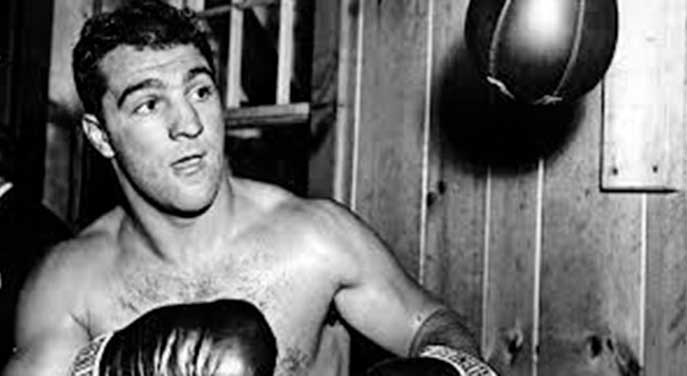 When professional boxing was still a mainstream sport, it often caught the fancy of young boys who’d immerse themselves in the newspaper build-up to championship fights and root passionately for their favourites.
When professional boxing was still a mainstream sport, it often caught the fancy of young boys who’d immerse themselves in the newspaper build-up to championship fights and root passionately for their favourites.
And because it’s natural to identify with a winner, you often adopted whoever was the heavyweight champion at the time your interest was sparked. For me, that was Rocky Marciano, who fought his last fight in 1955.
Born Rocco Marchegiano, he was one of six children in a blue-collar Italian immigrant family; his father came from Abruzzo, and his mother from Campania. Because his surname was a problem for contemporary ring announcers, he changed it to the more easily pronounceable, but still Italian-sounding, Marciano.
To put it mildly, Rocky Marciano wasn’t an elegant fighter. With him, it was all about brute force, relentless aggression, and destructive punching power. As the famous New Yorker writer A. J. Liebling piquantly expressed it, Rocky was “a dreadfully severe hitter with either hand.”
 |
| Related Stories |
| Luis Ángel Firpo was boxing’s Wild Bull of the Pampas
|
| Floyd Patterson: the boxer who came back
|
| Jack Dempsey and the birth of the Roaring ’20s |
And sometimes, he wasn’t overly fastidious. In addition to his fists, his elbows and head might come into contact with his opponent, and a blow might stray below the belt or even land when the other guy was already on his knees. Reporting on the battering administered to the Englishman Don Cockell, the travelling British press waxed apoplectic, with veteran journalist Peter Wilson describing it as “legalized cobblestone brawling.”
Today, Rocky would be an unlikely heavyweight champion. Shy of six feet in height and weighing no more than 190 pounds, he’d be considered too small for 21st-century competition. But whatever he lacked in physical dimensions, he made up for in durability, power and tireless ferocity. Rather than outboxing his opponents, he bludgeoned them into submission.
Rocky’s last fight – at New York’s Yankee Stadium on September 21 – went pretty much according to script, although the more than 61,000 spectators certainly got their money’s worth along the way. His opponent, Archie Moore, was a veteran of indeterminate age. Depending on who you believed, he was either 38 going on 39, or 41 going on 42. But age notwithstanding, he was a highly skilled and worthy challenger who firmly believed that he’d not only beat Rocky but actually knock him out in the process.
Indeed, for a brief moment in the second round, it looked as if this self-belief might be vindicated, courtesy of a right-hand delivered with what Liebling called “classic brevity and conciseness.” But dumped on the floor for only the second time in his career, Rocky promptly got up at the count of two. And, indestructibility thus reaffirmed, he went on to put Archie away in the ninth.
The year 1955 was also big for another favourite. While I’d been too young to be aware of Sugar Ray Robinson’s first incarnation, I’d seen the pictures and read the stories and was thus caught up in the romance of his 1955 return to the ring. “They never come back,” my father said as he cautioned me that it wasn’t going to work out well. For once, though, he was wrong.
Stylistically, Sugar Ray was very different from Rocky. Elegant and skillful, he was also a lethal puncher. Where Rocky was one-dimensional, Sugar Ray had it all. In the conceptual world of ‘pound for pound’ – an imaginary category that the boxing fraternity invented to facilitate comparisons negating the influence of weight – he was considered one of the very best ever.
And although his comeback wasn’t without a hiccup, by December 1955 he was fighting to regain the middleweight championship from Carl “Bobo” Olson, the man who’d won the vacant title after Sugar Ray’s retirement. Entering the ring as a decisive underdog, he made the pundits look ridiculous by demolishing Olson in the second round.
Rocky Marciano retired undefeated and resisted all attempts to lure him back to the ring. Then on August 31, 1969, he died in a small plane crash in Iowa. He would have turned 46 the following day.
Sugar Ray continued to fight for another 10 years, losing and regaining his title a couple of times before settling in for a long decline marked by losses to relative non-entities. When he finally retired in 1965, he was virtually penniless. Subsequently diagnosed with diabetes and then Alzheimer’s, he died at age 67 in 1989.
Troy Media columnist Pat Murphy casts a history buff’s eye at the goings-on in our world. Never cynical – well, perhaps a little bit.
For interview requests, click here.
The opinions expressed by our columnists and contributors are theirs alone and do not inherently or expressly reflect the views of our publication.
© Troy Media
Troy Media is an editorial content provider to media outlets and its own hosted community news outlets across Canada.

